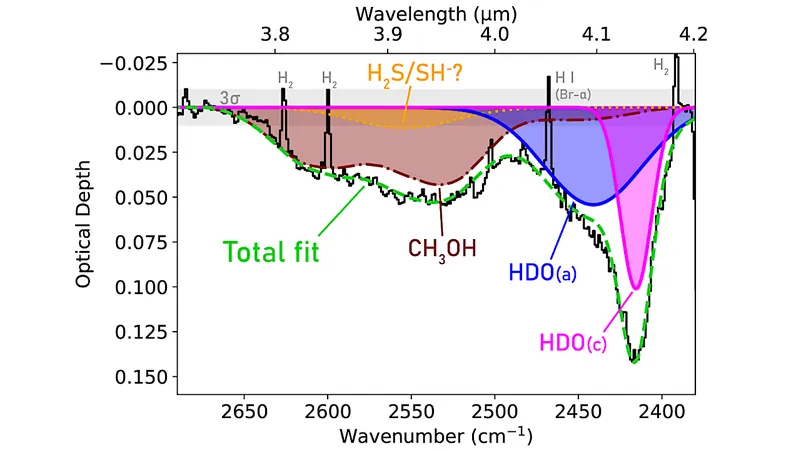
Revolutionary Ice Discovery: HDO Detected Towards Low-Mass Protostar!
2025-07-28
Author: John Tan
Unveiling Water's Cosmic Journey
In an astonishing breakthrough, scientists have detected HDO ice—indicative of the presence of water—in the depths of space, shedding light on one of the universe's most enigmatic elements. Water, vital for life as we know it, plays a crucial role in star and solar system formation, yet its chemical evolution remains a captivating mystery.
A Glimpse into the Future: Low-Mass Protostar L1527 IRS
Using the powerful James Webb Space Telescope (JWST), researchers have made the groundbreaking finding of the 4.1 µm HDO ice feature toward L1527 IRS, a low-mass protostar that has the potential to evolve into a sun-like star. This discovery is pivotal, as it allows scientists to calculate an HDO/H2O ratio of 4.4+3.7−1.7×10−3, offering vital clues about the chemical relationships within cosmic regions.
Linking the Past and Future of Water in Space
The measured ratio closely resembles those found in warm inner cores of other low-mass protostellar envelopes and protoplanetary disks in similar isolated star-forming environments. This similarity tentatively suggests that the water vapor detected in these areas remains largely unchanged by subsequent gas-phase reactions—a significant point in understanding how water is preserved in the cosmos.
Comparing Cosmic Neighbors: A Tale of Two Worlds
Interestingly, the HDO to H2O ratio detected in L1527 IRS is approximately 4 to 10 times higher than those observed in comets and low-mass protostars situated within clustered star-forming regions. This intriguing discrepancy could hint at complex gas-phase water interactions in protostellar envelopes or highlight the stark differences between isolated dense cores and more chaotic star-forming environments like the one where our very own Sun emerged.
The Next Steps in Stellar and Solar Evolution Research
As researchers continue to unravel the complex narratives of water in star formation, this cutting-edge discovery opens new avenues for exploring the origins of water across the universe. The implications of these findings may not only enhance our understanding of cosmic chemistry but may also deepen our insights into the formation of our own solar system.



 Brasil (PT)
Brasil (PT)
 Canada (EN)
Canada (EN)
 Chile (ES)
Chile (ES)
 Česko (CS)
Česko (CS)
 대한민국 (KO)
대한민국 (KO)
 España (ES)
España (ES)
 France (FR)
France (FR)
 Hong Kong (EN)
Hong Kong (EN)
 Italia (IT)
Italia (IT)
 日本 (JA)
日本 (JA)
 Magyarország (HU)
Magyarország (HU)
 Norge (NO)
Norge (NO)
 Polska (PL)
Polska (PL)
 Schweiz (DE)
Schweiz (DE)
 Singapore (EN)
Singapore (EN)
 Sverige (SV)
Sverige (SV)
 Suomi (FI)
Suomi (FI)
 Türkiye (TR)
Türkiye (TR)
 الإمارات العربية المتحدة (AR)
الإمارات العربية المتحدة (AR)